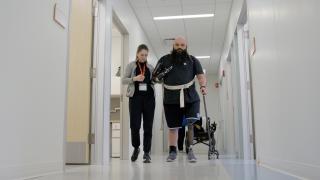Normal Bladder Function and Urination
Body
After a disabling event, it is common for bladder habits to change. Some people have problems emptying the bladder, while others may have urinary accidents. The first step in learning to deal with these changes is to learn how the urinary (bladder) system works. These are some common urinary terms:
Bladder - balloon-like muscle that holds urine
Kidneys - organs that filter blood and remove waste
Ureters - thin tubes that drain urine from the kidneys to the bladder
Urethra - tube that drains urine from the bladder to the outside of the body
Sphincter - muscle between the bladder and the urethra
There are two kidneys, one on each side toward the back just below the ribs. The kidneys remove waste from the blood and turn it into urine. Once urine is made, it moves through the ureters and then into the bladder where it is stored. To keep urine from leaking out, the bladder wall stretches like a balloon and the sphincter muscle at the bottom of the bladder tightens.
When enough pressure builds up, a message is sent from the bladder to the brain. The brain then signals the bladder to hold it a little longer; or a reflex causes the bladder walls to tighten and the sphincter muscle to relax. Then, the pressure pushes urine down through the urethra and out of the body.
Effects of Disability on the Bladder
Body
A disability may affect the bladder in these ways:
Incontinence - Accidental loss of urine
Urinary frequency - Needing to urinate more than once every two hours
Urinary retention - Inability to empty bladder completely; increases risk of infection.
Dysuria - Problems starting the urine stream or pain during urination.
Urinary urgency - Very sudden need to empty the bladder
Bladder Program
Body
A good way to deal with bladder problems is to develop a routine called a bladder or toileting program which includes the following:
Drinking plenty of fluids, spaced throughout the day. It is alright to drink less after dinner to avoid urinating often at night.
For some people, emptying the bladder completely is difficult and a catheter can be used to drain urine from the bladder. Intermittent catheterization is the process of passing a tube through the urethra into the bladder at certain times in order to drain the urine. Indwelling catheterization leaves the tube in place to drain urine all day.
Those using a catheter are taught how to use it by a healthcare professional. This includes care of the catheter; getting on and off the toilet seat; and managing clothes and hygiene.
People with communication difficulties are taught how to alert others of the need to use the bathroom.
Family communication is often another important part of urinary care. Although bladder changes can be very embarrassing, it is important to talk about them with family. Honest communication will make rehabilitation easier for you and your family.
Bladder Management Options
Body
Management | Description | Advantages | Disadvantages | Things to Consider |
Timed voiding | Urinating at set intervals to avoid accidents and retrain bladder | No risk for infection | None | If bladder empties well and can hold urine for a reasonable amount of time |
Urinating without control | Urine that empties without control and is managed by a collecting device or pad | Low risk of infection Requires very little time | Wearing an external collecting device May cause skin problems | Good option for men if bladder only; not for women as there is no collecting device other than a pad or diaper |
Intermittent catheterization without urination | Emptying the bladder at specified intervals using a catheter | Less chance of infection, if followed as prescribed No need to wear external collecting device | Need to catheterize around the clock; waking at night | Best for those who are independent in their care |
Intermittent catheterization with urination | Emptying the bladder at specified intervals using a catheter; frequency depends on how well the bladder empties with urination | Less chance of infection | May need to catheterize at night | Not appropriate for females due to lack of effective external collecting device |
Indwelling catheter | Hollow tube from bladder attaches to a bag worn on the leg or hung on the side of the bed | None | Greater chance of infection | Optimally, used short term
|
Body
This content is for informational purposes only and may not be comprehensive. Information contained does not imply an endorsement from Shirley Ryan AbilityLab, and does not replace the advice of a qualified healthcare professional. See here for further details. © Shirley Ryan AbilityLab (formerly Rehabilitation Institute of Chicago). Henry B. Betts LIFE Center – (312) 238-5433 – https://www.sralab.org/lifecenter



